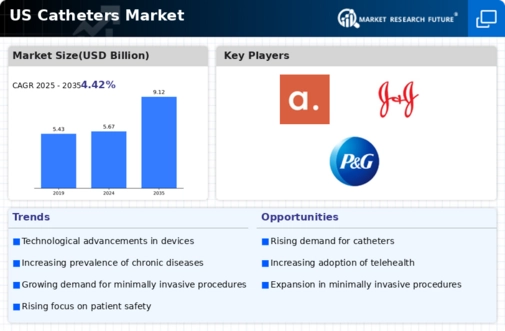Rising Geriatric Population
The increasing geriatric population in the US is a significant factor driving the catheters market. Older adults often face multiple health challenges, including mobility issues and chronic illnesses, which may require catheterization for effective treatment. Current statistics indicate that by 2030, nearly 20% of the US population will be aged 65 and older. This demographic shift is likely to result in a higher demand for catheters, as healthcare providers adapt to the unique needs of elderly patients. The catheters market is expected to benefit from this trend, as more healthcare facilities implement strategies to cater to the growing number of older adults requiring catheter-related interventions.
Increased Focus on Infection Control
The heightened emphasis on infection control in healthcare settings is driving the catheters market. Catheter-associated urinary tract infections (CAUTIs) are a significant concern, prompting healthcare providers to adopt safer catheterization practices. The implementation of stringent infection control protocols and the development of antimicrobial catheters are becoming standard practices in hospitals. Recent studies indicate that the adoption of these measures can reduce CAUTIs by up to 30%. As healthcare facilities prioritize patient safety and strive to minimize infection rates, the demand for innovative catheter solutions is likely to increase, thereby positively impacting the catheters market.
Expansion of Healthcare Infrastructure
The ongoing expansion of healthcare infrastructure in the US is a crucial driver for the catheters market. With the establishment of new hospitals, outpatient facilities, and specialized clinics, the accessibility of catheterization services is improving. This expansion is particularly evident in underserved areas, where healthcare access has historically been limited. As more facilities are equipped to provide catheter-related services, the overall demand for catheters is expected to rise. Projections suggest that the healthcare infrastructure investment could reach $500 billion by 2027, further supporting the growth of the catheters market as new facilities integrate advanced catheter technologies into their services.
Increasing Prevalence of Chronic Diseases
The rising incidence of chronic diseases such as diabetes, cardiovascular disorders, and renal failure is a primary driver for the catheters market. As these conditions often necessitate catheterization for effective management, the demand for various types of catheters is expected to grow. According to recent data, approximately 30% of the US population is affected by chronic diseases, leading to a heightened need for medical interventions. This trend suggests that healthcare providers are increasingly relying on catheters for both short-term and long-term patient care. Consequently, the catheters market is likely to experience substantial growth as healthcare systems adapt to the needs of an aging population and the rising prevalence of these conditions.
Technological Innovations in Catheter Design
Innovations in catheter technology are significantly influencing the catheters market. Developments such as antimicrobial coatings, advanced materials, and smart catheters equipped with sensors are enhancing patient safety and comfort. For instance, the introduction of catheters with integrated monitoring systems allows for real-time data collection, which can improve clinical outcomes. The market for these advanced catheters is projected to expand, with estimates suggesting a growth rate of around 8% annually. As healthcare providers seek to improve patient experiences and reduce complications associated with catheter use, the demand for technologically advanced products is likely to rise, further propelling the catheters market.

















Leave a Comment